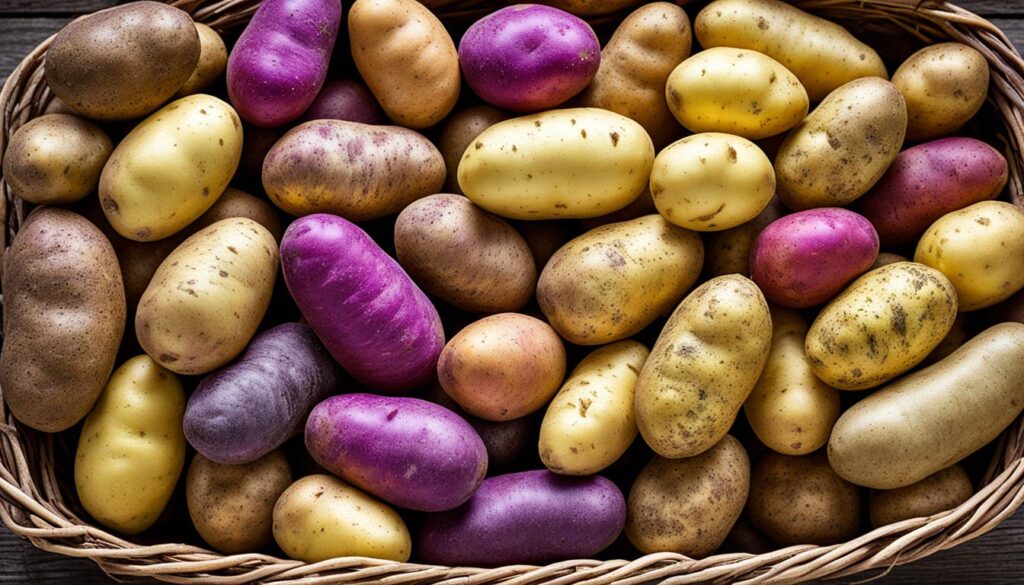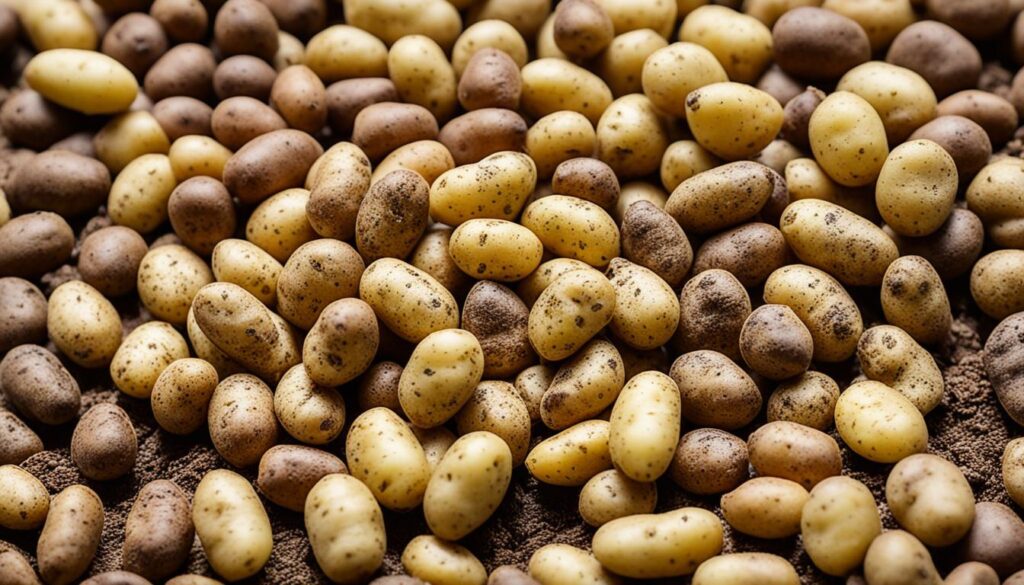How to Plant Potatoes: A Guide for Home Gardeners
Watching potatoes grow is very rewarding. They are easy to grow and can thrive in small spaces. I want to share how to grow potatoes at home. This guide is for everyone, from experts to beginners.
Key Takeaways
- Discover the benefits of growing potatoes at home and the best varieties for your garden.
- Learn how to properly select and prepare potato seeds for planting.
- Understand the soil requirements and planting techniques for optimal potato growth.
- Explore strategies for caring for your potato plants and managing pests and diseases.
- Uncover the secrets to harvesting and storing your homegrown potatoes for long-term enjoyment.
Understanding the Potato Planting Process
Growing potatoes at home is rewarding and saves money. It lets you enjoy fresh produce. You can also try different potato types not found in stores.
Why Grow Potatoes at Home?
Planting potatoes at home has many benefits. You control the growing conditions. This means your potatoes won’t have harmful chemicals or pesticides.
Homegrown potatoes taste better than store-bought ones. They also have a unique texture. Plus, it’s a fun activity for the whole family.
Potato Varieties for Home Gardens
There are many potato types perfect for home gardens. Some favorites include:
- Yukon Gold: A classic yellow-fleshed potato with a buttery flavor and creamy texture.
- Red Norland: A red-skinned potato with a moist, waxy texture that’s great for roasting and boiling.
- Fingerling: Small, oblong-shaped potatoes with a delicate, nutty flavor and firm flesh.
- Blue Adirondack: A unique, vibrant blue-skinned potato with a dense, creamy interior.
These are just a few of the many varieties you can grow. Trying different types is a fun way to find your favorites and try new recipes.

“Homegrown potatoes are not only fresher and more flavorful, but they also allow you to explore a wider range of potato varieties that may not be readily available in grocery stores.”
Selecting and Preparing Potato Seeds
Choosing the right potato seeds is key to a great harvest. It’s important to pick the best seeds and prepare them well before planting. I’ll show you how to pick and prepare your potato seeds for the best growth.
Choosing the Best Seed Potatoes
Start with high-quality seed potatoes for a good harvest. Look for ones that are disease-free and match the type you want. Pick potatoes that are firm, without blemishes, and have good eyes. Don’t choose those that are shriveled, sprouted, or rotting.
Preparing Potato Seeds for Planting
After picking your seed potatoes, get them ready for planting. Cutting and curing the potatoes is crucial for strong plants. Cut the big potatoes into pieces, making sure each has an eye. Let these pieces dry for a few hours to form a protective layer.
Then, cure the potato pieces. Put them in a cool, dark place with good air flow for 10-14 days. This helps the cuts heal and eyes sprout, giving your plants a good start.
| Potato Seed Preparation Steps | Description |
|---|---|
| 1. Choose certified disease-free seed potatoes | Select seed potatoes that are firm, free of blemishes, and have intact eyes. |
| 2. Cut seed potatoes into pieces | Cut larger seed potatoes into pieces, ensuring each piece has at least one eye. |
| 3. Allow cut pieces to dry | Let the cut seed potato pieces sit for a few hours to allow the cut surfaces to dry and form a protective callus. |
| 4. Cure the seed potato pieces | Place the cut and dried seed potato pieces in a well-ventilated, cool, and dark area for 10-14 days to allow the cut surfaces to heal and the eyes to sprout. |
By following these steps, you’ll be ready for a great potato harvest in your garden.

Preparing the Planting Site
Growing potatoes needs the right spot and soil. The spot and soil quality are key for a good harvest. You must know the best soil and how to make it perfect for potatoes.
Soil Requirements for Potato Cultivation
Potatoes do well in soil that drains well, is loose, and full of nutrients. The soil should be a bit acidic to neutral, with a pH of 5.0 to 6.5. Stay away from heavy clay soils that stop potatoes from growing big.
Choose a spot with loamy or sandy loam soil instead. This type of soil lets roots grow deep and tubers develop well.
Before you plant, add organic stuff like compost or manure to the soil. This makes the soil better and gives your potatoes what they need to grow strong.
Creating Raised Beds or Trenches
Creating raised beds or trenches helps potatoes grow better. Raised beds help with drainage and let you control the soil. Build a frame 4-6 inches high and fill it with topsoil and compost.
You can also plant potatoes in trenches. Dig trenches 8-12 inches wide and 4-6 inches deep, and keep them 3 feet apart. This method helps with air and water in the soil, and it’s easy to hill the plants later.
Whether you use raised beds or trenches, make sure your potato planting site gets lots of sunlight. At least 6 hours of direct sunlight a day is best for your potatoes to grow and give you a big harvest.
How to Plant Potatoes
Planting Depth and Spacing
Planting your potatoes right is key for a great harvest. Let’s look at the best way to plant them deep and spread them out. This will help your potato plants grow strong.
For how to plant potatoes, put them 3 to 4 inches deep in the ground. This depth covers them well and lets them grow strong roots. If you plant them too shallow, they might get too much sun. This can make them green and not safe to eat.
For potato planting spacing, put the seed potatoes 12 to 18 inches apart. Keep rows 2 to 3 feet apart. This lets the plants grow big without fighting over space. It also helps air move around, which keeps moisture away and fights disease.
When you plant, put the seed potatoes in the ground with the “eyes” up. Cover them with soil, leaving just the top bit out. This way, the potatoes stay safe and grow more stems and leaves. This means you’ll get more potatoes.
Potato planting depth and spacing are very important for a good potato crop. By doing it right, you’ll grow lots of tasty potatoes in your backyard.
Potato Planting Techniques
Planting potatoes at home can be done in different ways, each with its own perks. Two common methods are the trench method and raised bed planting. Let’s look at the good things about each method. This way, you can pick the best one for your garden and likes.
Traditional Trench Method
The traditional trench method is a well-known way to grow potatoes. You dig shallow trenches, 6 to 8 inches deep. Then, you put the potato seed pieces (cut potato sections with eyes) 12 inches apart in the trench.
As the plants grow, fill the trench with soil. This is called “hilling.” It helps the tubers grow right.
This method is good for gardeners with lots of space. It lets you easily get to the plants as they grow. It also keeps the potatoes from getting too much sun. This stops them from turning green and being bad to eat.
Raised Bed Planting
Another way to plant potatoes is in raised beds. You make a mound or bed, 8 to 12 inches high. Then, you plant the seed pieces 12 inches apart.
As the plants grow, add more soil or mulch around the stems. This makes the mound taller.
This method is great for bad soil or heavy clay. The raised bed helps with drainage and air in the soil. It also makes getting to the plants and harvesting easier.
Choosing between the potato planting techniques like the trench method for potatoes or raised bed planting for potatoes matters. The main thing is to give your plants the right conditions and care. This way, you can have a big potato harvest in your garden.
“Growing potatoes is a rewarding experience that can provide a steady supply of fresh, homegrown produce for your family.”
Potato Planting Season
Planting potatoes at the right time is key. The best time to plant potatoes changes with your local weather and soil. Here are some tips to follow.
In most of the U.S., plant potatoes in the spring, from March to May. This lets the plants grow in cool soil with enough moisture. But, the exact time can change with your local weather and potato type.
Early potatoes like Yukon Gold or Red Bliss can go in a few weeks before the main crop. These grow fast and can be planted early, even with some frost risk.
Late potatoes, such as Kennebec or Russet Burbank, go in a bit later, in late April or early May. This lets them grow well before the summer heat and dryness.
To find the best potato planting season for you, talk to your local gardening experts. They know the best times for your area’s weather and soil.
“The key to a bountiful potato harvest is getting the timing right. By planting at the optimal time, you can give your potato plants the best chance to thrive and produce a healthy crop.”
The potato planting season also depends on soil temperature, moisture, and frost risk. Watch these and adjust your planting to get a great potato harvest.
Caring for Potato Plants
Proper care is key for a great potato crop. You need to focus on watering, fertilizing, hilling, and mulching. These steps help your potato plants grow well and increase your harvest.
Watering and Fertilizing Potatoes
Water your potato plants regularly but don’t overdo it. They like moist soil but too much water can cause disease. Water them about 1 inch per week, depending on the weather and soil.
For fertilizing potatoes, use a balanced vegetable fertilizer. Put it on when you plant and again when they start to flower. Choose a fertilizer with more phosphorus to help tubers grow.
Hilling and Mulching Potatoes
Hilling is a key step for caring for potato plants. As they grow, cover the stems with soil to make a mound. This keeps the tubers safe from sunlight, which can make them green and bad to eat.
Mulching also helps your potatoes. Put 2-4 inches of organic mulch, like straw or leaves, around the plants. It keeps the soil moist, stops weeds, and protects the tubers.
By using these potato plant care tips, you’ll get a big potato harvest. Keep an eye on your plants and adjust your care as needed. This depends on your local weather and the type of potatoes you have.
Pest and Disease Management
Keeping potatoes healthy is a big job. They get attacked by pests and diseases that can ruin your harvest. I’ll show you how to spot and fight these problems. This way, your potatoes will grow well and you’ll get a good harvest.
Identifying and Preventing Common Potato Pests
The Colorado potato beetle is a big problem. These beetles eat leaves and can stop your plants from growing. Watch your plants closely and remove beetles and eggs you find.
The potato aphid also hurts potatoes. It sucks sap, making plants weak. Use things like insecticidal soap or neem oil to fight aphids.
- Check your plants often for pests
- Remove pests or eggs by hand
- Use safe pest control like soap or neem oil
Managing Common Potato Diseases
Diseases like late blight, early blight, and potato scab can harm potatoes. They can make plants look bad or even kill them.
To stop these diseases, keep your garden clean and remove sick plants. Change where you plant potatoes and pick strong varieties. If you see disease, use a copper-based fungicide.
- Keep your garden clean by removing sick plants
- Change where you plant to stop disease from spreading
- Pick potatoes that are resistant to disease
- Use a copper-based fungicide if you see disease
By watching your plants and using the right steps, you can beat potato pest and disease problems. This way, you’ll get a great potato harvest.
| Pest/Disease | Symptoms | Management Strategies |
|---|---|---|
| Colorado Potato Beetle | Striped beetles that defoliate plants | Monitor plants, remove beetles and egg masses, use insecticidal soap |
| Potato Aphids | Suck sap from leaves and stems, weaken plants | Use insecticidal soap or neem oil to control aphid populations |
| Late Blight | Discoloration, lesions, and plant death | Practice good garden hygiene, rotate crops, use disease-resistant varieties, apply copper-based fungicide |
| Early Blight | Circular lesions on leaves and stems | Practice good garden hygiene, rotate crops, use disease-resistant varieties, apply copper-based fungicide |
| Potato Scab | Rough, corky lesions on tubers | Practice good garden hygiene, rotate crops, use disease-resistant varieties, maintain proper soil pH |
“Proactive pest and disease management is the key to a successful potato harvest. Stay vigilant, and act quickly at the first sign of trouble.”
Harvesting and Storing Potatoes
Knowing when to pick your potatoes and how to keep them is key. I’ll tell you how to know when it’s time to pick them. I’ll also share tips on keeping your potatoes fresh and tasty.
When to Harvest Potatoes
The best time to pick potatoes depends on the type and how you plan to use them. Early types like Red Norland or Yukon Gold are ready in 2-3 months. They have thin skins and taste best right after picking. Late types, like Russet Burbank, take 3-4 months to grow.
Here are signs to know when to pick your potatoes:
- The potato plants have flowered and the flowers have died back.
- The leaves and stems have begun to die back and turn yellow.
- You can see the outline of the potatoes pushing up through the soil.
Proper Storage Techniques
Storing your potatoes right is important for keeping them fresh and tasty. Here are some tips:
- Cure the potatoes. Let them sit in a cool, dark place for 1-2 weeks after picking. This makes the skins tough and heals any cuts or bruises.
- Choose the right storage conditions. Keep potatoes in a cool, dark place with lots of humidity. The ideal temperature is between 40-50°F (4-10°C). Don’t keep them in the fridge, as the cold can make them sweet.
- Use proper storage containers. Use bags or bins with holes for air to move in and out. Don’t use airtight bags or containers, as they can cause moisture and spoilage.
- Check your stored potatoes regularly. Take out any that are sprouting, shriveled, or rotten to stop them from affecting the others.
By following these tips, you can keep your potatoes fresh, tasty, and ready to eat for a long time.
Potato Gardening Tips for Beginners
Starting your potato garden is fun and rewarding, even if you’re new to gardening. You might face some challenges, but the right tips can help you grow lots of potatoes. Here are some great tips to get you started.
Start with the Right Potato Varieties
Picking the right potato types is key. Good choices for beginners are Yukon Gold, Red Bliss, and Russet Burbank. These are easy to grow, fight off diseases, and are great for cooking.
Prepare the Soil Properly
Potatoes do well in soil that drains well and has lots of nutrients. Before planting, add compost or manure to your soil. This gives your potatoes the food they need to grow big and healthy.
Master the Planting Technique
- Plant your potato pieces or seed potatoes 12 inches apart and 4 inches deep.
- As they grow, pile soil around the plants to make more tubers.
Water Consistently
Keep your potatoes moist all season. Water them 1-2 inches every week to help them grow big and strong.
Manage Pests and Diseases
Watch out for pests like beetles and aphids, and diseases like early and late blight. Use natural ways to fight pests and keep your garden clean to avoid problems.
Harvest and Store Properly
Know when and how to pick your potatoes for the best results. Dig them up when the plants start to die back after flowering.
Follow these potato gardening tips for beginners for a great potato harvest. With patience and care, your garden can be full of homegrown potatoes.
| Potato Variety | Description | Suitability for Beginners |
|---|---|---|
| Yukon Gold | A versatile yellow-fleshed potato with a buttery flavor and creamy texture. | Excellent |
| Red Bliss | A red-skinned potato with a firm, waxy texture and a slightly sweet taste. | Very Good |
| Russet Burbank | A classic russet potato with a light, fluffy interior and a crisp, golden-brown skin. | Good |
Potato Farming Techniques for Larger Yields
I love growing potatoes at home and always look for ways to get more. There are advanced farming techniques that can boost your potato harvest. Let’s explore some methods to help you grow more potatoes.
Succession Planting
Succession planting is a great way to grow more potatoes. You plant potatoes at different times during the season. This way, you get potatoes for longer and use your space well. It’s great if you have little garden space.
Intercropping
Intercropping means growing potatoes with other plants. It uses your garden space better and can make potatoes healthier. Good plants to grow with potatoes are leafy greens, radishes, and some herbs.
High-Density Planting
High-density planting means planting potatoes closer together. This lets you grow more potatoes in a small area. But, be careful not to plant too close to avoid small potatoes.
| Technique | Description | Benefits |
|---|---|---|
| Succession Planting | Planting potatoes at different intervals throughout the growing season | Extends the harvest period and ensures a steady supply of fresh potatoes |
| Intercropping | Growing potatoes alongside other compatible crops | Maximizes garden space and can enhance plant growth and health |
| High-Density Planting | Planting potatoes closer together than traditional spacing | Increases the number of plants in a given area, leading to higher overall yields |
Using these techniques can make your potato harvest bigger and more reliable. Try succession planting, intercropping, or high-density planting to see what works for you. With planning and trying new things, you can have a lot of potatoes every year.
“Farming is a profession of hope. Time and again you must start all over, hoping for the best.” – Henri Nouwen
Conclusion
I’ve shared important tips on how to plant and grow potatoes at home. You now know how to pick the right seed potatoes and harvest them. You can grow a great potato patch.
These tips help both new and experienced gardeners grow lots of potatoes. You learned how to plant potatoes, follow a potato planting guide, and grow them at home. You’re now a potato-growing expert.
With this guide, you can start growing potatoes and enjoy fresh, homegrown ones. It’s fun to watch your potatoes grow and harvest them yourself. Enjoy your homegrown potatoes!







